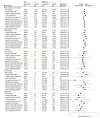Association Between Proton Pump Inhibitor Use During Early Pregnancy and Risk of Congenital Malformations
- PMID: 36626173
- PMCID: PMC9856708
- DOI: 10.1001/jamanetworkopen.2022.50366
Association Between Proton Pump Inhibitor Use During Early Pregnancy and Risk of Congenital Malformations
Abstract
Importance: Proton pump inhibitors (PPIs) are increasingly used during pregnancy; however, several observational studies have raised concerns about an increased risk of specific types of congenital malformations.
Objective: To examine the association between PPI exposure during early pregnancy and the risk of congenital malformations.
Design, setting, and participants: This population-based cohort study used data from the National Health Insurance Service-National Health Information Database of South Korea (2010-2020); sibling-controlled analyses were conducted to account for familial factors. A total of 2 696 216 pregnancies in women aged 19 to 44 years between June 1, 2011, and December 31, 2019, and their live-born infants were identified. Pregnant women who were exposed to known teratogens or who delivered infants with chromosomal abnormalities or genetic syndromes were excluded. Data on participant race and ethnicity were not collected because the National Health Information Database does not report this information.
Exposures: Proton pump inhibitor use during the first trimester.
Main outcomes and measures: Primary outcomes were major congenital malformations, congenital heart defects, cleft palate, hydrocephalus, and hypospadias. The subtypes of major congenital malformations and congenital heart defects were evaluated as exploratory outcomes. Propensity score fine stratification was used to control for potential confounders, and a weighted generalized linear model was used to estimate relative risks with 95% CIs.
Results: Of 2 696 216 pregnancies (mean [SD] maternal age, 32.1 [4.2] years), 40 540 (1.5%; mean [SD] age, 32.4 [4.6] years) were exposed to PPIs during the first trimester. The absolute risk of major congenital malformations was 396.7 per 10 000 infants in PPI-exposed pregnancies and 323.4 per 10 000 infants in unexposed pregnancies. The propensity score-adjusted relative risks were 1.07 (95% CI, 1.02-1.13) for major congenital malformations, 1.09 (95% CI, 1.01-1.17) for congenital heart defects, 1.02 (95% CI, 0.72-1.43) for cleft palate, 0.94 (95% CI, 0.54-1.63) for hydrocephalus, and 0.77 (95% CI, 0.51-1.17) for hypospadias. In the sibling-controlled analyses, no associations were observed between PPI use and primary outcomes, including major congenital malformations (odds ratio, 1.05; 95% CI, 0.91-1.22) and congenital heart defects (odds ratio, 1.07; 95% CI, 0.88-1.30). A range of sensitivity analyses revealed results that were similar to the main findings.
Conclusions and relevance: In this cohort study, the use of PPIs during early pregnancy was not associated with a substantial increase in the risk of congenital malformations, although small increased risks were observed for major congenital malformations and congenital heart defects; findings from sibling-controlled analyses revealed that PPIs were unlikely to be major teratogens. These findings may help guide clinicians and patients in decision-making about PPI use in the first trimester.
Conflict of interest statement
Figures




References
-
- Ali RAR, Egan LJ. Gastroesophageal reflux disease in pregnancy. Best Pract Res Clin Gastroenterol. 2007;21(5):793-806. - PubMed
-
- Nikfar S, Abdollahi M, Moretti ME, Magee LA, Koren G. Use of proton pump inhibitors during pregnancy and rates of major malformations: a meta-analysis. Dig Dis Sci. 2002;47(7):1526-1529. - PubMed
Publication types
MeSH terms
Substances
LinkOut - more resources
Full Text Sources
Medical

